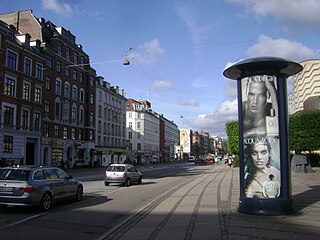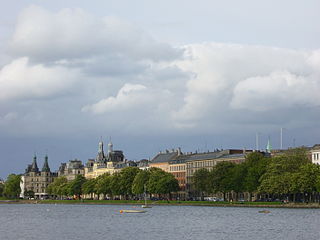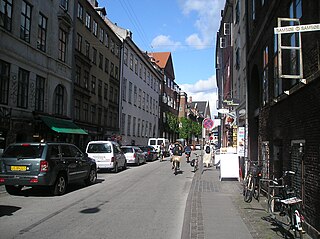
City Hall Square is a public square in the centre of Copenhagen, Denmark, located in front of the Copenhagen City Hall. Its large size, central location, and affiliation with the city hall makes it a popular venue for a variety of events, celebrations and demonstrations. It is often used as a central point for measuring distances from Copenhagen.

Vester Voldgade is a street in Copenhagen, Denmark which runs from Jarmers Plads to the waterfront between Frederiksholms Kanal and Langebro, passing the City Hall Square on the way.

Nørre Voldgade is a street in central Copenhagen, Denmark. It runs north-east from Jarmers Plads for approximately 600 metres to Gothersgade where it turns into Øster Voldgade. The succession of Nørre Voldgade, Øster Voldgade and Vester Voldgade together forms a traffic artery which arches around the Zealand side of the central and oldest part of Copenhagen. Nørreport Station, Denmark's busiest railway station, is located in the street.

Sønder Boulevard is a boulevard in the Vesterbro district of Copenhagen, Denmark, whose broad central reserve has been turned into a linear park with various facilities for sports and other activities. It runs from Halmtorvet next to Copenhagen Central Station in the north east to the Carlsberg district in the southwest.

The Royal Horse Guards Barracks, at 26 Frederiksholms Kanal in Copenhagen, Denmark, served as barracks for the Royal Horse Guards from 1792 until 1866. The building is located along the south side of a gated alleyway which connects Frederiksholm Canal to Vester Voldgade. Together with Civiletatens Materialgård and Fæstningens Materialgård, it forms a cluster of low, yellow-washed buildings all of which are listed, on the Zealand side of the canal, opposite the small island Slotsholmen with Christiansborg Palace. The Hay Storage Building at the end of the barracks building, facing Vester Voldgade, originally stored hay for the King's horses at the Royal Stables but later also served the Royal Horse Guards. Both the Royal Horse Guards Barracks and the Hay Storage building are now used by the Ministry of Education.

Palace Hotel is a residential hotel on the eastern side of City Hall Square in Copenhagen, Denmark. Influenced by the Art Nouveau style, the red brick building was designed by Anton Rosen and completed in 1910.

Gammel Kongevej is the principal shopping street of Frederiksberg in Copenhagen, Denmark. Running roughly parallel to Frederiksberg Allé and Vesterbrogade, it extends from Vesterport station at the southern end of The Lakes and continues for some 1.8 km west to Frederiksberg City Hall Square where it continues as Smallegade. In the opposite end, Jernbanegade connects it to Copenhagen City Hall Square.

H. C. Andersens Boulevard is the most densely trafficked artery in central Copenhagen, Denmark. The 1.3 km long six-lane street passes City Hall Square on its way from Jarmers Plads, a junction just north of Vesterport station, to Lange Bridge which connects it to Amager Boulevard on Amager. From Jarmers Plads traffic continues along Gyldenløvesgade which on the far side of The Lakes splits into Aaboulevard and Rosenørns Allé. At the City Hall Square the boulevard meets Vesterbrogade, another very busy and importaint street. Major landmarks along the street include Copenhagen City Hall, Copenhagen Central Fire Station and the Ny Carlsberg Glyptotek.

Allégade is the oldest street in the Frederiksberg district of Copenhagen, Denmark. It runs from Frederiksberg Runddel to Frederiksberg Town Hall Square, along the east side of Frederiksberg Gardens, connecting Pile Allé to Falkoner Allé. The streetscape is, in spite of the central location, characterized by houses that are pulled back from the street with front gardens behind white fences. Several buildings are old country houses from the time when Frederiksberg was a summer destination outside Copenhagen. Along the northernmost part of the street, on its west side, is a narrow garden complex, Digterlunden with a statue of Holger Drachmann.

Ny Kongensgade is a street in central Copenhagen, Denmark, connecting Frederiksholm Canal to H. C. Andersens Boulevard. In the opposite direction, The Prince's Bridge connects the street to Tøjhusgade on Slotsholmen.

Ny Vestergade is a street in central Copenhagen, Denmark. It runs from Frederiksholms Kanal to Vester Voldgade and together with Christiansborg's riding grounds, Marble Bridge and Dantes Plads forms an axis between Christiansborg's tower in the east and Ny Carlsberg Glyptotek's dome in the west. The National Museum's main entrance is located in the street.

Vester, Nørre and Øster Søgade is a succession of streets along the eastern side of The Lakes in central Copenhagen, Denmark. The streets run from Gammel Kongevej to the south to the beginning of Østerbrogade at Lille Trianglen in the north. Vester Søgade runs from Gammel Kongevej to Gyldenløvesgade, Nørre Søgade runs from Gyldenløvesgade to Dronning Louises Bro, and Øster Søgade from Dronning Louises Bro to Lille Triangel.

Vester Farimagsgade, Nørre Farimagsgade and Øster Farimagsgade is a succession of streets which together connect the south-western Vesterbro to the northern Østerbro along the periphery of the city centre in Copenhagen, Denmark. A continuation of Reventlowsgade, Vester Farimagsgade extends from Vesterbrogade at Vesterport Station and initially runs along the sunken railway tracks on the left before soon reaching H. C. Andersens Boulevard. It then turns into Nørre Farimagsgade and continues behind Ørsted Park to Gothersgade where it becomes Øster Farimagsgade and proceeds along another green space, the Copenhagen Botanical Garden, passes Sølvtorvet and the neighbourhood of terraced houses known as Kartoffelrækkerne before terminating at Lille Triangel where Østerbrogade begins.

H. C. Ørsteds Vej is a street in the Frederiksberg district of Copenhagen, Denmark. It runs from Gammel Kongevej in the south to Åboulevard on the border with Nørrebro in the north, linking Alhambravej in the south with Griffenfeldsgade in the north.

Studiestræde is a street in central Copenhagen, Denmark, running from Bispetorv on Nørregade in the northeast to Axeltorv in the southwest. The oldest section of the street, between Nørregade and Vester Voldgade, is part of Copenhagen's Latin Quarter and is home to many small shops, galleries and cafés. Most of the buildings date from the years after the Copenhagen Fire of 1795. The rest of the street dates from an extension in the second half of the 19th century. It is bisected by H. C. Andersens Boulevard and is home to the music venue Pumpehuset.

Kokkedal Slot is a former country house located in Hørsholm north of Copenhagen, Denmark. It is now operated as a 62-room, high-end hotel under the name Kokkedal Slot Copenhagen to distinguish it from Kokkedal Slot in North Jutland. The hotel is a member of the Small Luxury Hotels of the World (SHL) network. It is surrounded by parkland and an 18-hole golf course.

Aage Langeland-Mathiesen was a Danish architect. He was active both in building design and restoration, and was associated with the National Museum for many years. His building designs are strongly influenced by his interest in historic architecture. He collaborated with his more well-known colleague Ulrik Plesner on many projects.

Philip Smidth was a prolific Danish architect in the late 19th and early 20th centuries. His works included, commercial properties, high-end apartment buildings, hotels and hospitals. He worked in the Historicist style. Two of his works, Liselund Ny Slot on the island of Møn and Gefion and Gylfe in Copenhagen, have been listed by the Danish Heritage Agency.

The Russian Centre for Science and Culture in Copenhagen is located at Vester Voldgade 11 in central Copenhagen, Denmark.

Vester Voldgade 19 is a Neoclassical property located at the corner of Vester Voldgade and Studiestræde in the Latin Quarter of Copenhagen, Denmark. The building was listed on the Danish registry of protected buildings and places in 1974. It is now owned by Esbjerg Municipality.






















